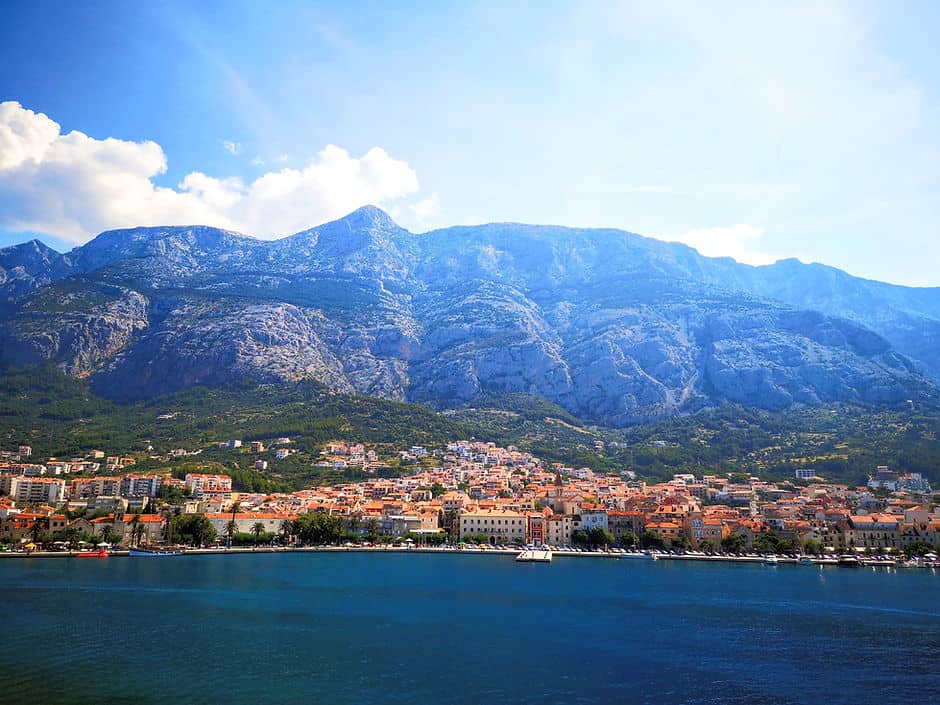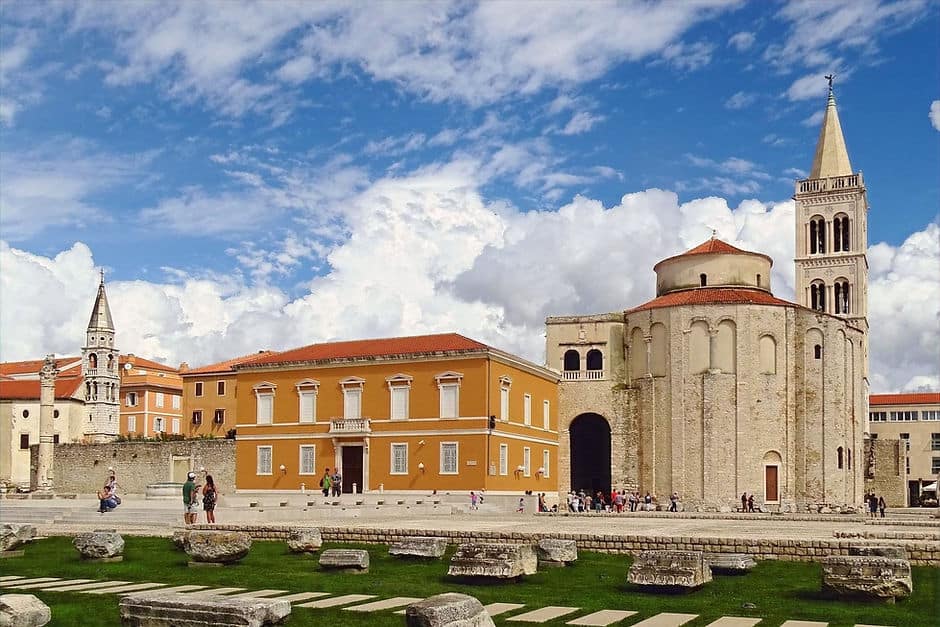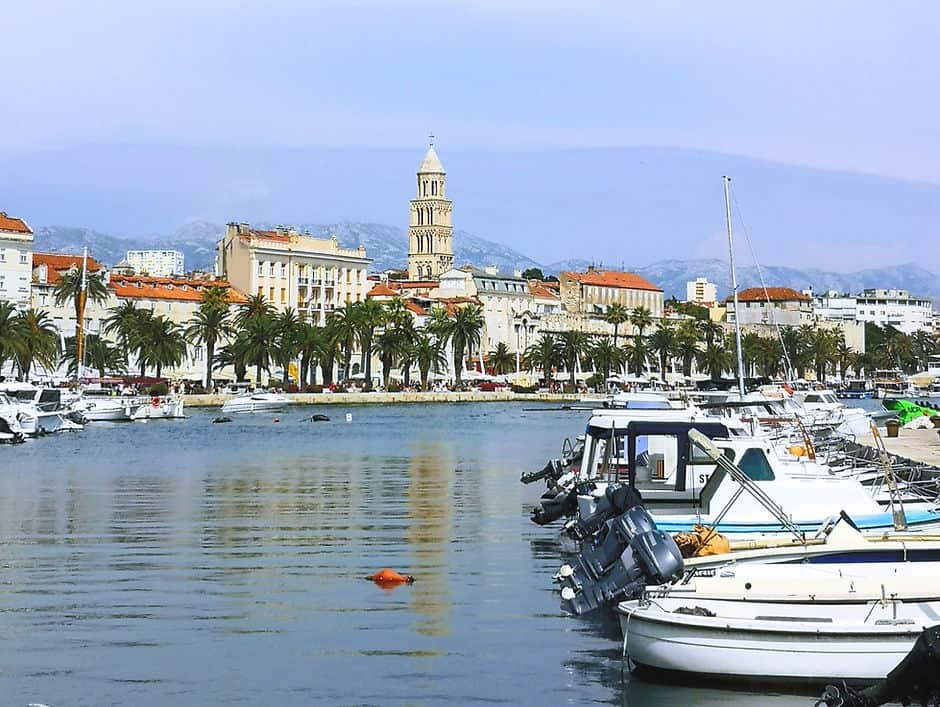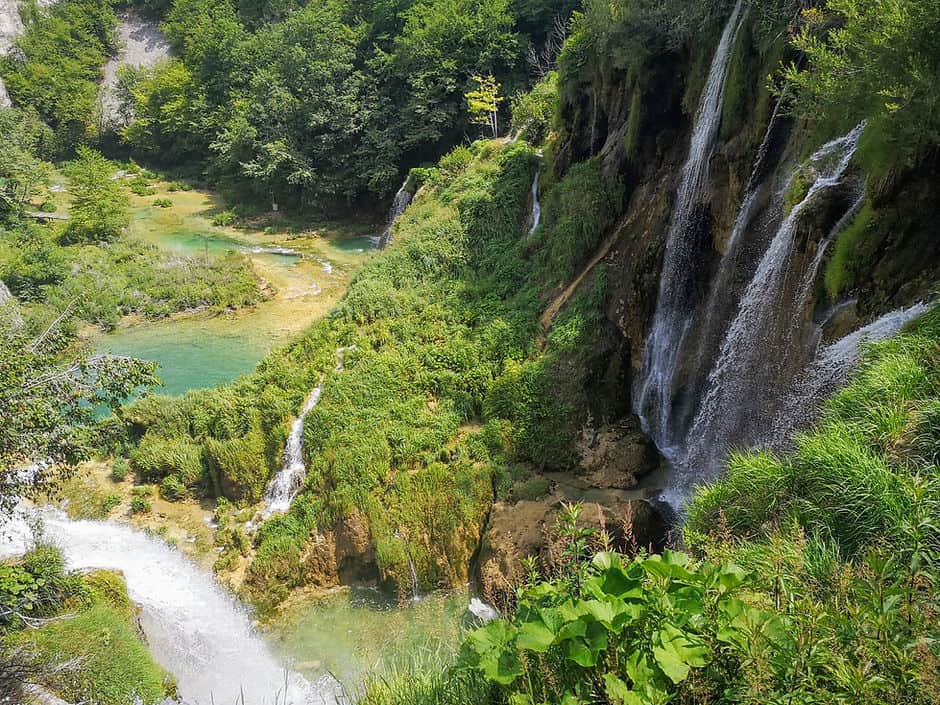
This post may contain affiliate links. I receive a small commission if you use these links, with no extra cost to you.
Krka or Plitvice Lakes? Which is better?…let’s find out!
Croatia is blessed with 8 stunning national parks; Krka, Plitvice Lakes, Mljet, Brijuni Islands, Kornati, Paklenica, Risnjak and Northern Velebit. The most popular national parks in Croatia are Krka National Park and Plitvice Lakes National Park. These two parks are both known for their beautiful waterfalls and dramatic scenery. They are also both very accessible from the busy hot spots of Zagreb, Zadar and Split, making it really convenient to take a day trip to Krka or Plitvice.
During my two week holiday in Croatia, I planned a road trip from Split to Zadar and incorporated both Krka and Plitvice Lakes into my itinerary and enjoyed them both. However, if you have a limited amount of time and can only visit one, which national park is better? Krka or Plitvice Lakes?
Contents
1. Krka National Park
How to get to Krka National Park?
How much does it cost to visit Krka National Park?
What is there to do at Krka National Park?
Is Krka National Park worth visiting?
2. Plitvice Lakes National Park
How to get to Plitvice Lakes National Park?
How much does it cost to visit Plitvice Lakes National Park?
What is there to do at Plitvice Lakes National Park?
Is Plitvice Lakes National Park worth visiting?
3. Which National Park is Better? Krka National Park or Plitvice Lakes National Park?
4. Other National Parks in Croatia
Krka or Plitvice Lakes? Which Croatian National Park is better?
In this post, I’ll cover some key facts about both Krka and Plitvice National Park, including the cost, how to get there and what to see, so that you can decide which one is best for you.
Krka National Park
Krka National Park is one of the most visited, and beautiful, national parks in Croatia. It is most known for the Skradinski Buk Waterfall, which is the main attraction in the park. Another reason that Krka National Park is so popular is due to its convenient location, in between Zadar and Split.
How to get to Krka National Park?
Zadar to Krka: Krka National Park is one of the best day trip destinations from Zadar. If you have your own car, it is an easy 50 minute drive to Krka, following the main roads. However, the cheapest way to travel from Zadar to Krka is by bus. The bus takes between 1 hour – 1.5 hours and leaves from Zadar bus terminal and arrives at the Skradin entrance of Krka National Park. Tickets cost just €10 one way (£8.50) and you can check the schedule here.
Split to Krka: Split to Krka takes only 1 hour driving in your own car along the major roads. My husband and I rented a car for a few days whilst we were in Croatia and we drove from Split to Krka, spent the day here, then continued driving onto Zadar, where we spent the following few days. If you are visiting Krka from Split on a daytrip, the cheapest way to travel is by bus. The bus from Split to Krka takes 1.5 hours and you will arrive at the Skradin entrance. Bus tickets cost just €10 one way (£8.50) and you can check the schedule here.
Of course, if you prefer to take the hassle out of driving or relying on public buses, you can join an organised day trip to Krka National park from either Zadar or Split.
There are five entrances to the park, the two main ones are Skradin and Lozovac. There is car parking at both these locations and the entrance at Skradin is also where the bus stop is located. These two entrances are closest to the Skradinski Buk waterfall, which is the most popular attraction in the park.
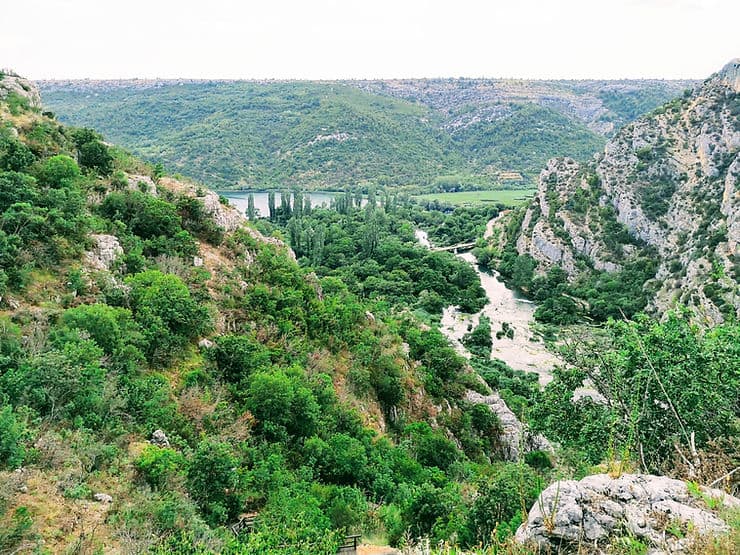
How much does it cost to visit Krka National Park?
Tickets prices for Krka National Park vary, depending on the time of year:
- High season: July & August – 200 kuna (£23) per adult
- Shoulder season: April – June and September & October – 110 kuna (£12.50) per adult
- Low Season: November to March – 30 kuna (£3.50) per adult
If you choose to visit the park on your own, rather than with a tour, you will need to purchase your tickets.
You can purchase tickets on the day at the ticket office, however in the busy summer months, it is recommended to purchase your ticket in advance to avoid queuing on the day.
What is there to do at Krka National Park?
Krka National Park is one of the most beautiful national parks in Europe and is known for its series of seven waterfalls, with the most famous being Skradinski Buk. As well as the seven waterfalls, there is also an impressive monastery and historic water mills to discover. Here’s some of the best things to do in Krka National Park.
Skradinski Buk
Skradinski Buk originally grew in fame as photos of people swimming in these beautiful falls were shared online. So, can you still swim in this waterfall? The answer is sadly, no. Previously visitors were allowed to swim in the base of the Skradinski Buk waterfall, however since 2021, swimming has been banned here and unfortunately swimming is no longer allowed.
However, you can still admire the beautiful and impressive Skradinski Buk waterfall from the walking trail. One of the most popular walking trails in Krka National Park is the Skradinski Buk loop trail. Starting from the Lozovac park entrance, it’s an easy walk, following wooden platforms over the water and through the forest.
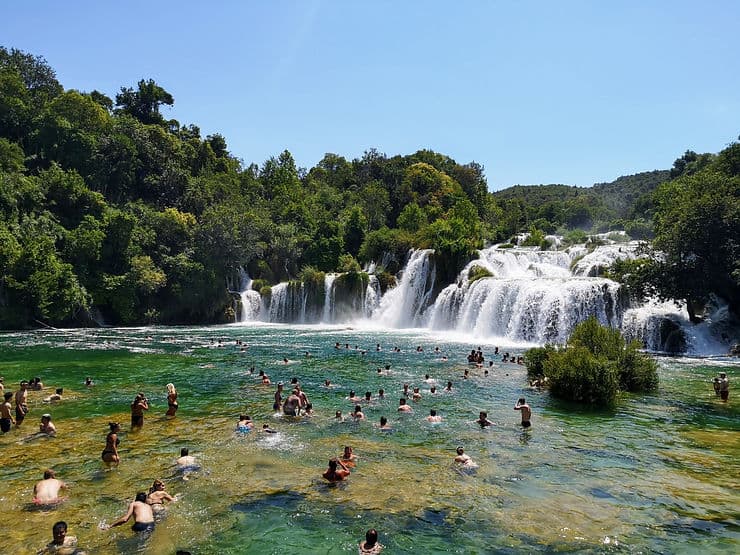
Ozidana Pecina cave
The small tunnel shaped cave of Ozidana Pecina sits above Roski Slap and you can see it as you walk along the Stinice – Roski Slap – Oziđana Pećina nature trail. The cave has significant historic and archeological importance as traces of human dwellings were found here, which date back to 5,000 to 1,500 B.C
Roski Slap waterfall
Roski Slap is another popular waterfall in Krka National Park, and at 22m high, it is one of the most impressive waterfalls in the area. You have to walk down over 500 steps to reach the waterfalls, which sit below the Ozidana Pecina cave.
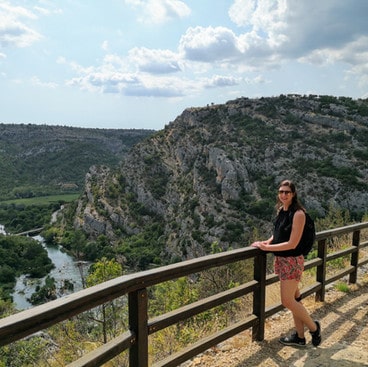
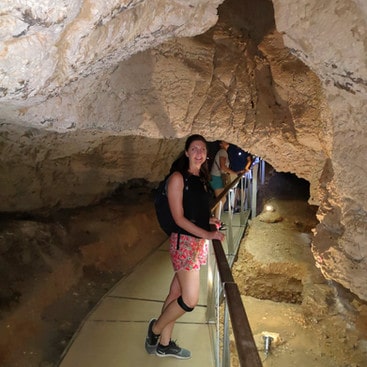
Roski Slap viewpoint outside of Ozidana Pecina cave in Krka National Park
Visovac Island and Monastery
Located in Visovac lake, close to Skradinski Buk is Visovac Island. Sitting in the centre of the small island is a 15th century Franciscan Monastery, surrounded by tall trees. You can only visit Visovac Island by booking a boat excursion, and the most convenient route is from Skradinski Buk, at a cost of 100 kuna per person (£11). The boat excursion includes a short, 30 minute visit to the Monastery and museum on the Island.
Visit an ethno village
There are two ethno villages in Krka National Park, one at Skradinski Buk and the other at Roski Slap. The ethno village is an example of traditional Croatian rural life. With old water and wheat mills housed in small stone buildings. Here you can also see a range of traditional crafts such as fabric weaving and ploughing.
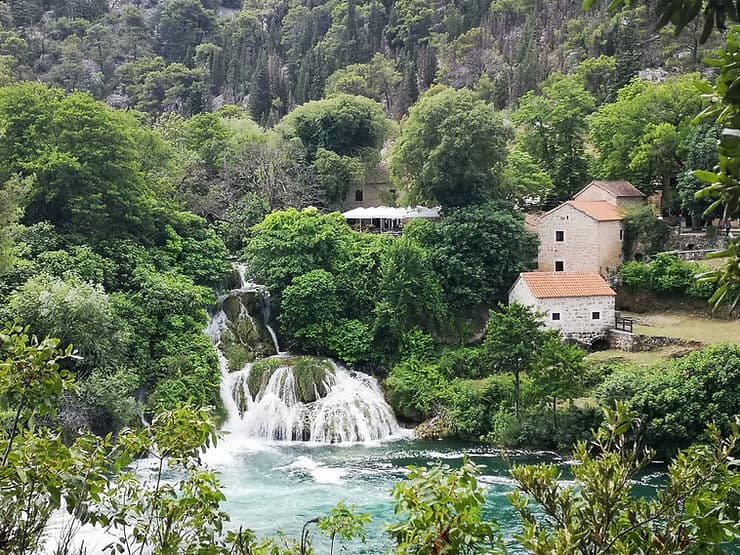
Is Krka National Park worth visiting?
If you are looking for an off-the-beaten track national park, where you can really get away from the crowds, then Krka definitely isn’t for you. However, the scenery is truly stunning and it’s a nice way to spend a day exploring the hiking trails and visiting the waterfalls. The best time to visit Krka National Park is in the shoulder season, during the months of April – June and September. Visiting at this time of year means there will be less people in the park and the weather is more pleasant for walking. Whatever time of year you visit, I would recommend getting there as early as possible and purchasing your tickets online to avoid queuing at the entrance.
Don’t forget to pin this post!
Plitvice Lakes National Park
Plitvice Lakes National Park is one of Croatia’s most popular tourist attractions and was given UNESCO world heritage status in 1979 and is a designated area of exceptional natural beauty.
Plitvice Lakes is Croatia’s largest National Park, covering 300 square kilometres. However, the main area around the 16 inter-connected lakes covers a more manageable 8 square kilometres. Even if you stick to the main, central area, you really do need a full day if you want to explore the best bits of the park. If you have your own car, it is definitely worth staying overnight within the National Park and there are many hotels and guesthouses in the area to choose from.
How to get to Plitvice Lakes?
Plitvice National Park is located inland, close to Croatia’s border with Bosnia and Herzegovina. The location, further away from the main coastal hot-spots of Zadar and Split, means that a great option is to have two full days exploring the park, or one long day with an overnight stay.
Zagreb to Plitvice Lakes: If you are travelling from Zagreb to Plitvice, you can go by bus. This would take 2.5 hours and cost between €12-15 (£10-13). If you have your own car, the journey will take 2 hours.
Zadar to Plitvice Lakes: From Zadar to Plitvice, it is a 1.5 hour drive if you have your own car. It is not possible to take a local public bus to Plitvice from Zadar, but there are several companies who offer excursions so you can take a day trip from Zadar to Plitvice Lakes.
Split to Plitvice Lakes: The distance between Split and Plitvice by car is 2.5 hours. Although there are many companies who offer excursions as a day trip from Split to Plitvice, it would result in a long day, with lots of travelling, so it may be worth considering an overnight excursion or hiring a car for two days and staying overnight in the park.
How much does it cost to visit Plitvice Lakes National Park?
You can buy either one day or two day tickets for Plitvice Lakes. (The two day ticket must be used on consecutive days). The entrance fee depends on the time of year you are visiting, the below prices are for a one day ticket.
- High season: June – September – 300 kuna (£33) per adult
- Shoulder season: April, May & October – 180 kuna (£20) per adult
- Low Season: November to March – 80 kuna (£9) per adult
The ticket price includes the use of the electric boat and panoramic shuttle train within the park. There are only a certain number of tickets which are sold for each entrance, each day, so you must book ahead to make sure you have your ticket on the date you want to visit.
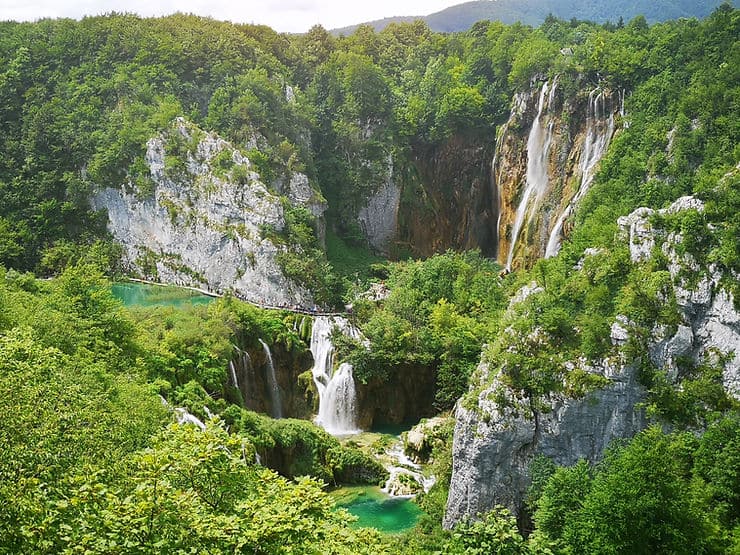
What is there to do at Plitvice Lakes National Park?
Plitvice Lakes National Park is famous for the 16 inter-connected lakes in the centre of the park and the great selection of walking routes and hiking trails that wind around the lakes. Even if you are not an avid hiker, there are plenty of ways you can enjoy the beauty of Plitvice.
The Lower Lakes
The Lower Lakes is the most popular and picturesque area in Plitvice Lakes. This area is where you will find Veliki Slap (known as ‘The Great Waterfall’), which is the largest waterfall in Plitvice Lake National Park. You will also see Supljara cave. If you take the short, steep climb up to the cave you will be rewarded with stunning views over the park. The Lower Lakes are located at entrance 1. I’d recommend getting here early – as soon as the park opens – to enjoy the walk and views with less people.
The Upper Lakes
The Upper lakes can be reached by taking the shuttle or by walking. This is a really beautiful area of the park, and walking on the wooden boardwalks over the emerald-blue lakes here is without a doubt one of the things that makes Plitvice Lakes so special.
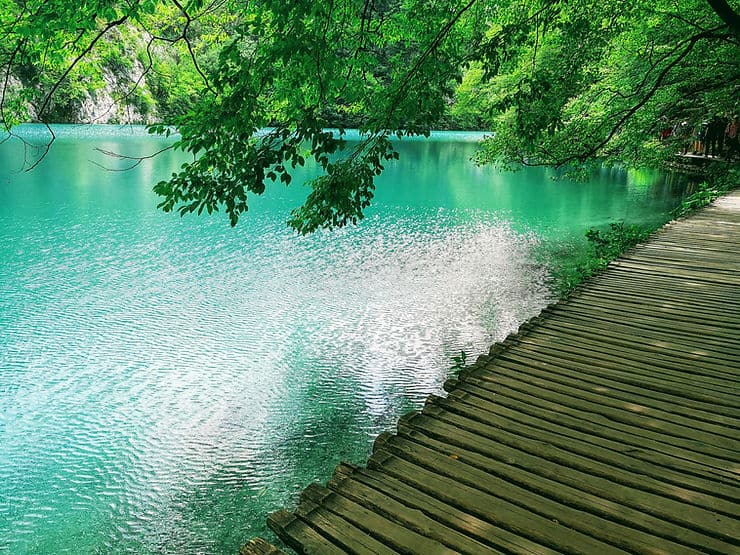
Lake Tour Program (Walking routes)
The best thing to do in Plitvice Lakes National Park is to follow one of the Lake Programs (walking routes). There are 7 ‘Lake programs’ to choose from and they are all well sign posted, either starting from entrance 1 or entrance 2.
Programs from entrance 1: Routes A, B and C leave from entrance 1 and are marked in green.
– Route A is the shortest route at just 3.5km. It covers the Lower lakes canyon and the Veliki Slap – the largest waterfall in Plitvice National Park.
– Route B is 4km and is largely the same as route A. However it will take you across Kozjak bridge, where you will board the electric boat (included in your entrance fee) to the other side of Lake Kozjak – the largest lake in Plitvice National Park. From here, you walk to the shuttle train, where you can catch a ride back to entrance 1.
– Route C is an extension of Route B. This route is 8km long and incorporates the Upper lakes and the Sastavci waterfalls, before returning to entrance 1 by shuttle.
Programs from entrance 2: Routes E, F and H leave from entrance 2 and are marked in orange. Programs from entrance 2 are basically the same as A, B and C from entrance 1, except they travel in the opposite direction and are slightly longer.
Route K – this route is 18.5 km and covers the whole of the central lake area, including the Great Fall, Lower Lakes and Upper Lakes. You can start this walk from either of the two entrances.
Which is the best walking route to take through Plitvice Lakes?
This really depends on how far you want to walk. Route C (or H from entrance 2) is the best route to take in order to see all the best bits of Plitvice without walking too far.
I did a combination of Route C, H and also picked up one of the hiking trails which followed the lake shoreline. I ended up walking about 22km but I was able to experience some of the quieter routes by picking up a hiking trail and getting away from the crowds.
Does it matter which entrance you start from? Entrance 1 is the main entrance of Plitvice Lakes National Park. I had read that this was the best position to start from as the waterfalls and views are always in front of you as you walk around the lake. But, Plitvice Lakes is simply beautiful so you will have gorgeous views and be surrounded by great scenery wherever you go!
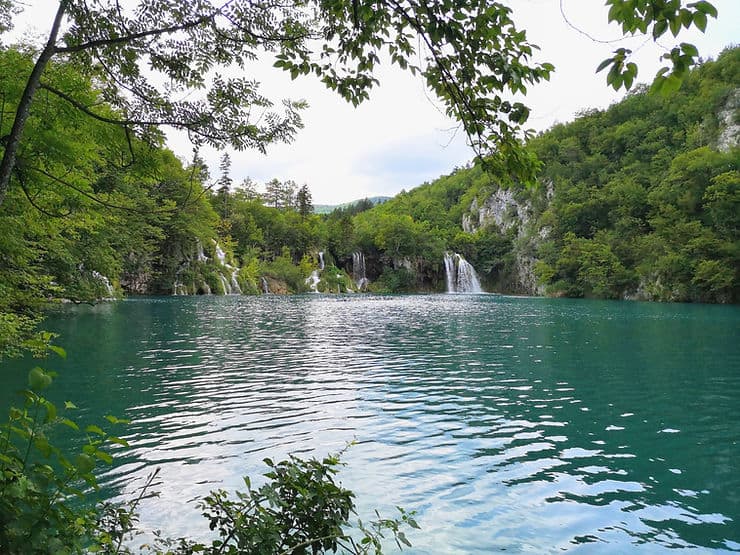
Hiking trails
If you want to get off the beaten track and explore further into the forest of Plitvice National Park, you can follow one of the hiking trails. There are several designated hiking trails through the forest, though these are not as well signposted as the Lake programs. The hiking trails are also not used as often, so the trails are not as easy to follow. If you are planning to go hiking in Plitvice National Park, make sure that you have a proper map of the area and you are an experienced hiker.
Rowing on Lake Kozjak
You can hire out small rowing boats to take out onto Lake Kozjak – the largest lake in Plitvice National Park. Rowing boats cost 100 kuna (£11) per hour and can seat a maximum of 4 people. This is a great activity to do in Plitvice if you want to see the impressive lake, without too much walking!
Is Plitvice Lakes worth visiting?
In a word, yes! Plitvice Lakes is one of the most beautiful National Parks in Europe. The wooden boardwalks over the bright blue-green lakes and waterfalls are spectacular.
The only downside of Plitvice Lakes is its popularity. As the wooden boardwalks over the lakes are narrow, it can feel quite crowded and in peak season. With this in mind, the best time to visit Plitvice Lakes National Park is in the shoulder season, during the months of April – June and September – October. I would highly recommend avoiding the peak months of July and August.
If you enjoy hiking, two days is a great amount of time to spend in Plitvice Lakes. This way, you can explore some of the lesser-trodden hiking trails. However, if you are short on time, then you can easily see the best bits in one long day.
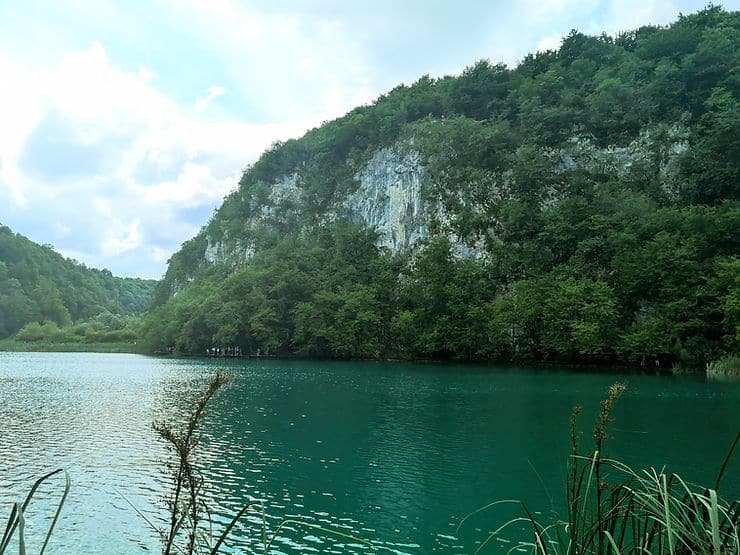
Which National Park is Better? Krka or Plitvice Lakes?
Both of these national parks are beautiful in their own way, it is not hard to see why they are Croatia’s most popular national parks.
You cannot swim in Plitvice Lakes national park as it is a designated unesco site and following the rule change in 2021, you can no longer swim in Krka National Park either. Previously, this was the main difference between the two parks, whereas now, it’s harder to pick between them!
Krka is a great choice if you don’t have lots of time to spare, as it is much easier to get to and closer to the main tourist hubs of Zadar and Split. Krka is also much cheaper than Plitvice Lakes, not only for the entrance ticket, but also in terms of getting there, as you can take the public bus.
Plitvice Lakes is a much larger national park than Krka, so you will have more scenery to explore and discover. If you enjoy walking and hiking, Plitvice Lakes is probably a better choice for you. Personally, I think Plitvice Lakes is more picturesque than Krka. The now-iconic boardwalks over the lake really are beautiful.
Other National Parks in Croatia
If you have more time, or want to get away from the crowds and visit a quieter and lesser known national park in Croatia, you might want to consider visiting one of these:
Mljet National Park
The beautiful Mljet National Park is located on Mljet Island and is best accessed by boat from Dubrovnik. About a third of the island is designated as a National Park, surrounded by salt water lakes. One of the main attractions within Mljet National Park is the Benedictine Monastery on the small island of St Mary. This National Park is quieter and more peaceful, therefore if you are wanting to get away from the crowds, this is a good option.
Brijuni Islands
Off the shores of Pula in Croatia’s Istrian peninsula, the Brijuni islands can only be reached by taking a boat from the small town of Fazana. Sights within national park include the ruins of a 1st century Roman villa, as well as a safari park. Activities on the island include cycling, golf, kayaking and scuba diving. There are also a few hotels on the island if you wanted to spend the night here.
Kornati National Park
The Kornati islands consist of 140 islands and islets, 89 of which form the Kornati National Park. This is perhaps the most difficult national park to visit, with no regular ferries servicing the islands. You can book onto a boat excursion from Zadar, however you are limited to how much time you can spend on the islands. If you can stretch to charter a boat, this would be the best option. It’s probably no surprise that this national park is the least visited, with the islands here amongst the most untouched in Croatia.
Paklenica National Park
Just a one hour drive from Zadar, the Paklenica National Park is most popular with climbers and hiking enthusiasts. There are several hiking trails, ranging from 2 hours to 8 hours long. For the longer hikes, you can split them over two days, taking advantage of the mountain shelters. Paklenica is the most popular centre for climbers in Croatia and has over 500 marked routes of varying difficulty.
Risnjak National Park
Located right in the North of the country, the Risnjak National Park is more mountainous, with several woodland hiking trails and mountain bike routes. Due to its location, you would need your own transport, as it is very difficult to reach by public transport.
Northern Velebit
Similar to Paklenica, the Northern Velebit is still relatively wild and mountainous, which makes it popular with more experienced hikers.

